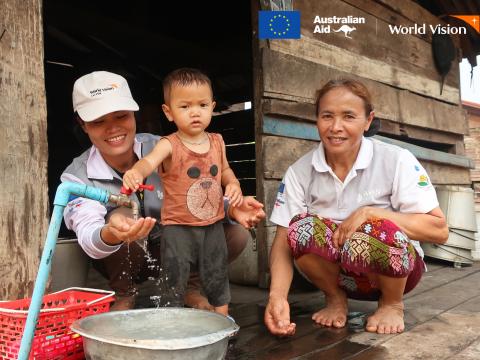When water empowers women, it empowers communities

Clean water, bright life
This is the motto of Mrs. Phaivan.
She shares this advice with her four children and her 2-year-old grandson, Kopy. She remembers how hard it was to access this vital resource, but also acknowledges the progress made in her country, compared to her childhood. In 2018, while 84% of Lao PDR households had access to basic water sources country-wide[1], only 55% had this privilege in the three southern provinces targeted by the Accelerating Healthy Agriculture and Nutrition (AHAN) Project[2].
Napaly is one of the 65 villages targeted by the AHAN project in Saravane Province with support from the European Union and the Australian Department of Foreign Affairs and Trade (DFAT). The village was an all too common illustration of the lack of reliable water supply in southern Lao rural communities. The only borehole available often broke, and no one in the TaOi ethnic village was able to repair it. When the precious resource was out of order, the 496 residents of Napaly had to collect their water from open sources, kilometers away from home rendering them exposed to several water-borne diseases.
Accessing clean water as a nutrition-sensitive intervention is critical in tackling malnutrition. To guarantee sustainable access to the blue gold for the most vulnerable, World Vision’s AHAN Project has been establishing Village Water and Sanitation Management Committees (VWSMC) in its target villages, with the support of the local WASH authorities. In Saravane Province, the project has trained the committee members on seven essential actions to ensure their new water systems are well managed and maintained. Phaivan has taken over the financial role for Napaly village after the building of a new water tower and the renovation of the old borehole. In close collaboration with the accountant, Phaivan is keeping track of the incomes received from the water users, processing all transactions with the local bank, and issuing the invoices. This self-sufficient committee is now able to take care of the usual repairs thanks to the newly trained technician, also a member of the committee. The community made fast progress. “With the pipe connection from the tower to our house, it is now so easy and convenient to access water,” says an enthusiastic Phaivan, contrasting with the previous time spent daily to fetch water, only 3 years ago. As a result, the hygiene practices of the family have improved, and Kopy is an important beneficiary of this change: his mother and grandmother have more time to care for him.
Through her new role, Phaivan also sees a transformation in the decision-making process of her village. “I’m delighted to work in my new role and proud to have a positive impact on the children and the community of my village,” she says. By holding the financial responsibility of such an important natural resource for the community, Phaivan inspires other women to take initiatives, including her two daughters. They will soon attend the upcoming Community-Change activity, gender-sensitive financial literacy training, and other gender awareness campaigns implemented by AHAN, with the desire to develop a more gender-equitable community in Napaly.
As a new role-model in her village, Phaivan is proof that when water empowers women, it empowers communities.
[1] Lao Social Indicator Survey II 2017
[2] AHAN Project baseline survey, 2018 – Attapeu, Saravane and Savannakhet Provinces
The AHAN Project is supported by the European Union, and by the Australian Government through the Australian NGO Cooperation Program (ANCP).